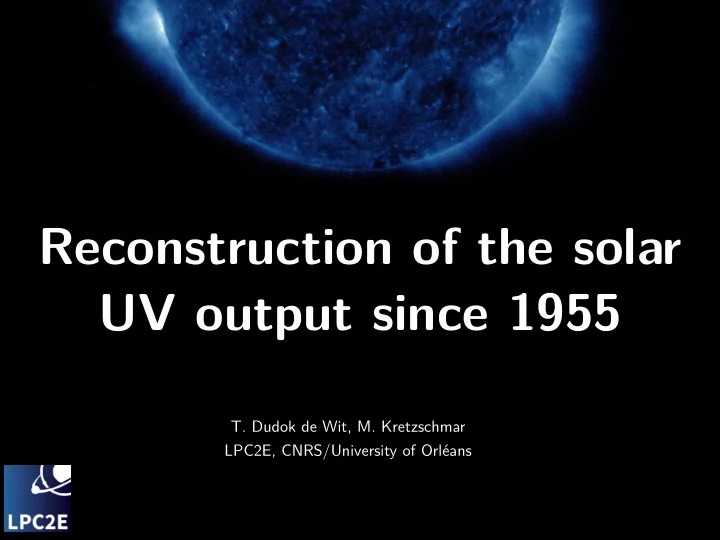

Reconstruction of the solar UV output since 1955 T. Dudok de Wit, M. Kretzschmar LPC2E, CNRS/University of Orléans
Open questions How does the observed solar UV output vary on the long term ? What was its level during the Maunder era ? How was it before the 1990’s ? Space Climate 2019 2
Existing UV reconstructions Using solar irradiance models : e.g. NRLSSI2, SATIRE, … Using solar CaK images [Bertello et al., 2010, Chatzistergos’ talk] Using geomagnetic data 1.0 a S M D UACs (aromatic/OH) [Svalgaard, 2016] 0.8 0.6 0.4 0.2 16.90 b 1.0 UV-B irradiance (W/m 2 ) Using pollen 16.88 a S M D UACs (aromatic/OH) 16.86 0.8 [Jardine et al., 2016] 16.84 0.6 16.82 0.4 16.80 16.78 0.2 16.90 1300 1400 1500 1600 1700 1800 1900 2000 b Space Climate 2019 UV-B irradiance (W/m 2 ) 3 16.88 Calendar years CE 16.86 16.84 16.82 16.80 16.78 1300 1400 1500 1600 1700 1800 1900 2000 Calendar years CE
Challenge Are there other UV proxies that are accurate enough ? stable in time ? Space Climate 2019 4
Challenge Any there any other UV proxies that are accurate enough ? stable in time ? Yes !!! Nobeyema radio polarimeters 10.7 cm radio fl ux (Ottawa/Penticton) : since 1947 3.2, 8.0, 15, 30 cm radio fl ux (Toyokawa/Nobeyama) : since 1950’s http://spaceweather.cls.fr Space Climate 2019 5
Solar radio fl uxes Excellent radiometric stability : < 0.4 sfu/year Space Climate 2019 6
Connection between radio and UV ? The connection between UV irradiance and radio fl uxes is at best indirect (several mechanisms, optical thickness, geometrical e ff ects, …) [White et al., 2011] gyro-synchrotron emissions ➞ major sunspots ➞ sunspots gyro-resonance emissions ➞ plages, coronal loops Bremsstrahlung 1 3 10 30 100 wavelength [cm] Space Climate 2019 7
Solar variability Interpreting the total radio fl ux in terms of UV output is di ffi cult 6-month averages, rescaled Let's focus instead on the rotational variability = contributions from solar structures only Space Climate 2019 8
Example : Halloween event Rotational variability during halloween event (Oct. 2003) Halloween event Space Climate 2019 9
<latexit sha1_base64="9fHqpWb63gf1CEk0am9pVnzlWKY=">ADOnicjVJNTxRBEH07fsGKAnr0MnFjgpfNLPuwEUgXjxi4gIJS8jM0KyTna/09Khkwt/gqj/EP8LVk4SLB3+Ar4vBaAzRnkx39at6Vf26KyrTpDKed95xbt2+c/fe3Hz3/sKDh4tLy492qLWsRrHRVrovSisVJrkamwSk6q9Uqswi1K1G81eWf/ue6WrpMjfmpNSHWThNE+Okzg0hCZbh7MV89ydTJXrHS71vL4nw/3bGLRGb+M7ZGwXy50FTHCEAjFqZFDIYWinCFHx28cAHkpiB2iIaVqJ+BVO0SW3ZpRiREh0xnK3X6L5tzbnJWwY1ZJ+WsyXTwjp2Ccpm2rueKvJbNFb8rdSE57thOuUZsrI2rwjui/eNeR/8uzWgyOsSYaEmoqBbHq4jZLbdiT+7+psowQ0nM2kf0a9qxMK/v2RVOJdrt3Ybi/yaRFrX7uI2tcdGeUgui8EFuLBMNOSs08pKnstoqHzlrehtBb36thlhCT87ZkGU1dGVXgqG/ovRGlso8P31YEhjPRj5o+GvXtpZ7Q/8/uqbYW/z5VTYQ5P8BQr7JwAm3iNbYxZrcQZPuGz8X56lw4l1ehTqflPMYfw/nxE6hlquE=</latexit> <latexit sha1_base64="kzDwezESCy0pkQboE5duXouXkP4=">ADQnicjVJNb9NAEH1x+Sih0LQcuVhESOUSOXWI20upxIVjEaSt1FSR42yDFX9pvYZWVv8KV/gh/An+AXACceXA26mLQKiCtbw7+2bezL7dmRZJXBrP+9hylq5dv3Fz+Vb79sqdu6udtfX9Mq90pEZRnuT6cBqWKokzNTKxSdRhoVWYThN1MF08tf6D10qXcZ69NGeFOk7DeRafxFoCE06y8mi41xQsIsfOSO58r1Jp2u1/NkuH8b/cboPvkKGXv5WmsFY8yQI0KFAoZDO0EIUp+R+jDQ0HsGDUxTSsWv8I52uRWjFKMCIkuOM+5O2rQjHubsxR2xCoJf02mi4fk5IzTtG01V/yVZLboVblryWnPdsZ12uRKiRq8Ivov3mXk/KsFoMTbImGmJoKQay6qMlSya3Yk7u/qTLMUBCz9ox+TsS5uU9u8IpRbu921D8nyTSonYfNbEVPjen1IovJEbS0VDxgq1vOS5rLbKWdNby3o1a9VE4vpyTgbsqymNtrS8HAfzcYgsFvr8dDGhsB0N/OPjVS/ubvb7f23w+6O7uXDQVlnEfD7DBzgmwi2fYw4jVTvEW7/De+eB8cb453y9CnVbDuYc/hvPjJ+Lvrak=</latexit> <latexit sha1_base64="98qfe5PA6bE4bozeoY1Z7HisUQ=">ADY3icjVJtaxNBEJ7kfKlptWn1mwiLQUhBwqUXcy1SrfhFv0hF0xaGu4u27rk3tjbU8uRH+Kv8av+BH+AoN/8CT47vRZFiu5xuzPzDOzMzthHqvCuO7XRtO5dPnK1YVrcWl6zeW2yuru0VW6kiOoizO9H4YFDJWqRwZWK5n2sZJGEs98LZU2vfeyd1obL0tTnJ5WESHKfqSEWBATRpe8+75v4BmEarIktMS7KZFLNtvrzNy+EeDWZdc+N4fiCXSzNml3J7LS/wt9Guh8/gn8drJVhpLNKYpZRSQlJSslAjimgAt8B9cmlHNghVcA0JMV2SXNqgVvCS8IjADrDfgztoEZT6DZmwewIWL8GkxB98DJ4Kch2yC7SVHtuhFsSuOae92gjOsYyVADb0F+i/emef/8mwtho5og2tQqClnxFYX1VFK7oq9ufitKoMIOTArT2HXkCNmnvVZMKfg2m1vA7Z/Z0+LWj2qfUv6Ud9SMyLpPXcs4RpSZKj4Jed82iwfsGtYK0Yvfq0KmIlxW7AsjW1qMWz5A+8B8MNjJDveZv+AMKmP/SGg/NZ2l3v9b3e+stBZ/vR6VDRAt2mu9TF5Pi0Tc9oh0bI9pE+0Wf60vzmLDqrzq1T12aj5tykP5Zz5xenk7VH</latexit> Blind source separation The radio fl uxes at 5 wavelengths are very redundant Determine their main contributions by using Bayesian blind source separation Assume N X I ( t, λ ) = S k ( λ ) A k ( t ) S k ( λ ) ≥ 0 A k ( t ) ≥ 0 k =1 How many contributions N = ? Space Climate 2019 10
Interpretation of the contributions All the salient features of the rotational variability are captured by 3 contributions only (N=3) [Dudok de Wit et a., 2014] ––o–– S 1 mostly short wavelengths (“Gyro-synchrotron emissions”) ––o–– S 2 mostly intermediate wavelengths (“Gyro-resonance emissions”) ––o–– S 3 mostly long wavelengths (“Thermal/Bremsstrahlung”) Space Climate 2019 11
Interpretation of the contributions Amplitude of each contribution Space Climate 2019 12
Interpretation of the contributions Amplitude of each contribution MgII index Conclusion : the long-wavelength contribution S 3 is a proxy for the UV rotational variability Space Climate 2019 13
Interpretation of the contributions Conclusion : the intermediate-wavelength contribution S 2 is a proxy for the sunspot area Space Climate 2019 14
Reasoning in 4 steps Consider the rotational variability of the solar radio fl ux This rotational variability re fl ects the cycle variability [Preminger and Walton 2005, 2006; DdW et al., 2018] This variability has 3 contributions only, with long-wavelength contribution = proxy for the UV output intermediate-wavelength contribution = proxy for the sunspot area Did these contributions change since the 1950’s ????? Space Climate 2019 15
Long-term changes Consider 6-year averages (1/2 solar cycle) S 3 proxy for UV output S 2 proxy for sunspot area Conclusion the S 2 /S 3 (“spot-to-facula”) ratio has drifted considerably [see also Foukal, 2012] Space Climate 2019 16
Long-term changes Conclusion : before the satellite era, the long-wavelength contribution signi fi cantly deviates from what spectral irradiance models give Space Climate 2019 17
Final conclusion A new and stable UV proxy from synoptic solar radio observations Agreement with spectral irradiance models (NRLSSI2, SATIRE-TS) goes down before satellite era Warning : long-term changes in the solar UV output may be signi fi cantly di ff erent from what irradiance models suggest. Nobeyama centimetric radio observations will stop in ~2021 Space Climate 2019 18
Long-term changes Comparison between long-wavelength contribution S 3 and solar UV proxies Space Climate 2019 20
Long-term changes Conclusion : variations in the intermediate-wavelength contribution S 2 are in full agreement with the sunspot area (and sunspot number) Space Climate 2019 21
Long-term changes Conclusion : the short-wavelength contribution S 1 is highly intermittent and has a distinct long-term evolution Space Climate 2019 22
Recommend
More recommend